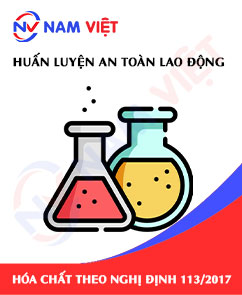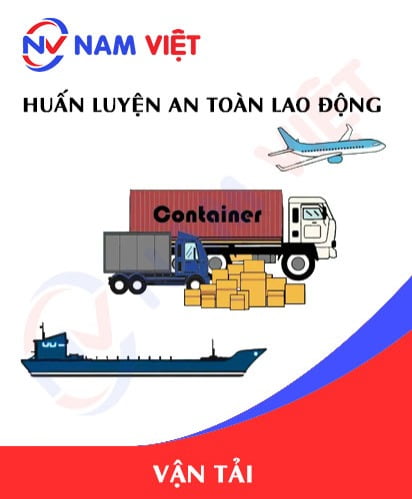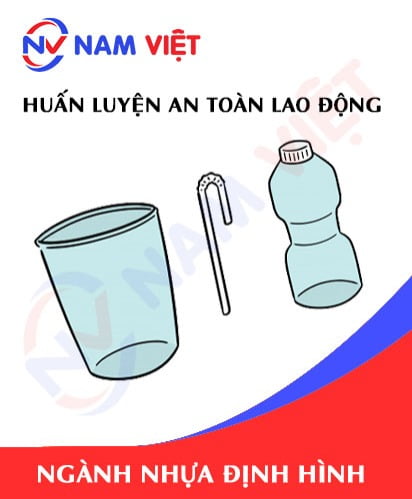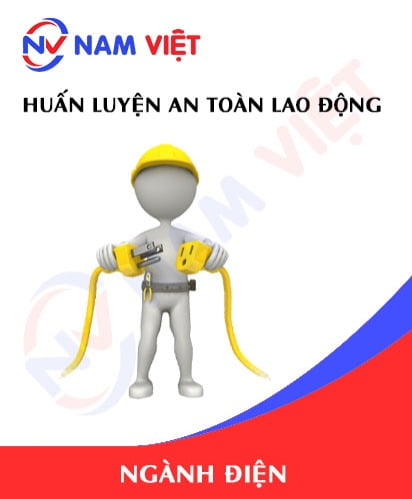Occupational safety training for the chemical industry in accordance with Decree 113/2017
99,000 ₫
Note: The price above is calculated for one person, and it may vary depending on the number of participants in the training course and market fluctuations. For more accurate pricing support, please refer to the quotation table or contact our consulting staff directly.
The Chemical Industry Occupational Safety Training course is designed to provide knowledge on Group 3 occupational safety. The course will raise awareness among participants about preventing workplace accidents during their work. Accordingly, the occupational safety training content strictly follows Decree 113/2017/ND-CP.
Table of Contents
Toggle1. Overview of the Chemical Industry under Decree 113/2017
a. Typical Hazardous Chemicals in Industry
In the chemical industry, there are many types of hazardous chemicals that workers and the environment must carefully manage to ensure safety. Below are some examples of common hazardous chemicals in manufacturing sectors:
- Hazardous chemicals for human health:
- Respiratory hazardous chemicals: Includes toxic gases, heavy metal vapors such as mercury, arsenic, and toxic organic compounds like aromatic solvents.
- Skin irritants: Includes strong acids, alkalis, and compounds that can cause skin irritation and allergies.
- Environmental pollutants:
- Water pollutants: Such as dioxins, PCBs, heavy metal compounds like mercury and lead, and organic compounds that may contaminate groundwater and surface water.
- Air pollutants: Such as chlorine gas, acid gases, ammonia, and other gases causing air pollution.
- Hazardous chemicals during production:
- Chemical reaction hazards: For example, reactions producing unwanted compounds or side reactions during production.
- Toxic additives and catalysts: Substances added to accelerate reactions may be toxic if not used correctly.
- Hazardous chemicals during transport and storage: Chemicals may become dangerous if leaked or come into contact with each other during transportation or storage.
- Hazardous by-products: In chemical production, hazardous by-products may be generated. For example, dioxin production can produce furan, another toxic compound.

b. Specific Jobs Related to Chemicals
REGISTER FOR OCCUPATIONAL SAFETY TRAINING SERVICE
Using chemicals is an important aspect of many professions, from industry to healthcare and agriculture. Below is a list of sectors that may involve chemical usage:
- Chemical Manufacturing and Production: Companies producing and processing chemicals, including organic and inorganic compounds, pesticides, fertilizers, additives, and other chemical products.
- Healthcare and Pharmaceuticals: Chemicals are used to produce drugs, diagnostic substances, and other medical products. Related fields include pharmaceuticals, medicine, and medical diagnostics.
- Agriculture: Chemicals are essential in agriculture for pest control, providing nutrients to crops, and protecting plants. This includes crop production and animal husbandry.
- Environmental and Environmental Engineering: Environmental specialists and engineers use chemicals to treat wastewater, manage waste, and monitor air and water quality.
- Food Industry: Chemicals are used to process, preserve food, and create flavor and color compounds.
- Oil and Gas Industry: Chemicals are used during extraction, production, and processing of oil and gas.
- Automotive Industry: Chemicals are used in car manufacturing and maintenance, including paints, lubricants, and coolants.
- Electronics Industry: Chemicals are used in producing electronic components, including plating and conductive materials.
- Pulp, Paper, and Textile Industry: Chemicals are used in processing raw materials and producing final products.
- Oils, Fats, and Household Chemicals: Includes production and distribution of soaps, detergents, cleansers, and related products.

2. Overview of Occupational Safety Training in the Chemical Industry under Decree 113/2017
a. Training Subjects
Group 1:
- Heads of units, production or business establishments, departments, and branches; responsible for production, business, or technical departments; workshop supervisors or equivalents;
- Deputy heads assigned to chemical safety responsibilities according to Clause 1, Point a of this regulation.

Group 2:
- Full-time or part-time chemical safety officers;
- Personnel directly supervising chemical safety at the workplace.

Group 3: Workers directly handling chemicals.

b. Training Content
Group 1:
- Legal regulations in chemical activities;
- Hazardous factors in production, business, storage, and chemical usage;
- Coordination plans with authorities to mobilize internal and external resources for incident response and mitigation.
Group 2:
- Legal regulations in chemical activities;
- Hazard characteristics of chemicals, safety data sheets, classification, and labeling of chemicals;
- Chemical safety management procedures and safe working techniques;
- Hazardous factors in chemical production, business, storage, and usage;
- Prevention and response measures; coordination with authorities; controlling pollution sources; environmental remediation after chemical incidents.
Group 3:
- Chemicals handled in production, business, storage, and usage: names, hazard characteristics, classification, labeling, and safety data sheets;
- Risks of chemical accidents;
- Chemical emergency response procedures: use of rescue equipment, fire/explosion/leak response, first aid, handling, storing, and checking safety and protective equipment, communication procedures, pollution containment, spill collection, and environmental remediation.
c. Training Duration
Initial Training
- Group 1: Minimum 8 hours including examination
- Group 2: Minimum 12 hours including examination
- Group 3: Minimum 16 hours including examination
Refresher Training
- After 2 years from initial training or when chemical types, technologies, or production plans change

3. How Dangerous is the Chemical Industry
The chemical industry poses potential risks to the health and life of workers due to exposure to hazardous chemicals. Below are some key hazards:
- Exposure to hazardous chemicals: Workers in the chemical industry may be exposed to harmful substances such as fumes, gases, chemical dust, and toxic liquids. Inhalation, ingestion, or skin contact with these substances can be harmful to health.
- Explosion and fire: The chemical industry often uses and produces explosive or flammable substances. An explosion or fire incident can cause serious injuries and threaten lives.
- Radiation and electrostatic effects: In some cases, workers may operate near radiation sources or electrostatic equipment. This can be harmful if safety measures are not followed.
- Risk of poisoning: Some chemicals can cause long-term poisoning, leading to severe health issues such as cancer, organ damage, and neurological disorders.
- Negative impact on respiratory system: Inhaling fumes, chemical dust, or toxic gases can cause bronchitis, asthma, and other respiratory problems.
- Impact on skin and eyes: Contact with many chemicals may cause skin irritation, dermatitis, or eye injuries.
- Impact on mind and nervous system: Some chemicals may affect the mind and nervous system, causing issues like blurred vision, memory loss, and psychological problems.
REGISTER FOR OCCUPATIONAL SAFETY TRAINING SERVICE
To reduce risks and ensure worker safety, chemical companies must comply with safety rules and regulations, ensure proper chemical handling, provide protective equipment, train workers in safety, and conduct regular inspections. Environmental authorities also monitor the handling, storage, and disposal of hazardous chemicals to ensure compliance and environmental protection.
4. Safety Measures for Workers Directly Handling Chemicals
Safety measures for workers handling chemicals are critical to protect their health and life. Below are basic safety measures that workers should follow when exposed to chemicals:
- Training and education: Ensure workers understand the chemicals they use, their health impacts, and how to handle them safely. Periodic chemical safety training should be provided.
- Use of protective equipment: Ensure workers use all required protective equipment such as masks, goggles, protective clothing, gloves, and safety shoes. The specific protective gear depends on the type of chemical and work process.
- Chemical inspection: Check chemicals before use to confirm their properties and ensure there are no leaks or hazards.
- Work in well-ventilated areas: Work in rooms with clean air and proper ventilation to avoid exposure to toxic fumes or gases. Use ventilation and exhaust systems if needed.
- Use safety equipment: Correctly operate safety devices such as vacuum systems, gas detection equipment, and toxic chemical storage containers.
- Proper chemical storage: Store chemicals in safe, isolated areas, avoiding contact with other substances that may react or explode.
- Regular safety inspections: Periodically check safety devices, machinery, and ventilation systems to ensure proper operation.
- Emergency response knowledge: Train workers on chemical emergency procedures, including fire extinguishing, toxic material disposal, and personal protection in emergencies.
- Compliance with rules and regulations: Follow chemical safety regulations and guidelines set by organizations and environmental authorities.
- Use safer chemical alternatives: Where possible, replace hazardous chemicals with safer alternatives to reduce risk for workers and the environment.
- Periodically conduct occupational environment monitoring in factories, collect and analyze harmful factors affecting workers, and adjust to reduce hazards and prevent occupational diseases.

5. Benefits of Chemical Industry Occupational Safety Training
An Toan Nam Viet provides businesses with the following benefits after completing occupational safety training as regulated in Decree 113/2017 on occupational health and safety for companies and enterprises:
- Workers can identify potential hazards and take preventive measures to avoid accidents.
- Businesses can implement risk prevention measures in production, operation, and maintenance processes.
- Reduce costs associated with occupational safety incidents.
- Uninterrupted production increases labor productivity and product quality.
- Compliance with labor safety laws reduces legal risks.
- Enhances reputation and professionalism, elevating the business brand.
Nam Viet’s training programs provide preventive solutions against external hazards, helping individuals avoid injuries or fatalities.

6. Occupational Safety Training Capability of An Toan Nam Viet
An Toan Nam Viet is a leading and reputable occupational safety training center in Vietnam. Training sessions are conducted continuously at factories, plants, and construction sites across all 63 provinces.
REGISTER FOR OCCUPATIONAL SAFETY TRAINING SERVICE
Occupational Safety Training License
- An Toan Nam Viet has been inspected and certified by the Department of Labor Safety under the Ministry of Labor – Invalids and Social Affairs, confirming eligibility to provide occupational safety and hygiene training. This strengthens our training capability.

Training Materials
- Before being used in OST courses, all materials are reviewed to ensure accuracy and effectiveness.
- Instructor methods follow An Toan Nam Viet standards, based on expert research in occupational safety and hygiene training to maximize knowledge absorption.
Facilities
- Classroom conditions are controlled to enhance teaching efficiency and knowledge retention.
- Training facilities provide spacious, standard classrooms with proper lighting, training equipment, etc.
7. Safety Materials
8. Chemical Industry Safety Training Activities
- KY NGUYEN ENVIRONMENTAL ENGINEERING JOINT STOCK COMPANY
- SEN VANG VIET NAM ONE MEMBER LIMITED LIABILITY COMPANY
- THIEN NAM ELEVATOR JOINT STOCK COMPANY
- FRIENDLY MATERIALS CO., LTD
- NGOC MINH CHAU INVESTMENT AND TRADING JOINT STOCK COMPANY
- JIA HUA TIEN GIANG CO., LTD
- KHOA THUONG BIO-TECHNOLOGY CO., LTD
- TOP SOLVENT (VIET NAM) CO., LTD
- TOYOTA THANH XUAN CO., LTD
1 review for Occupational safety training for the chemical industry in accordance with Decree 113/2017
No comments yet












caotiensyhung.07081999
Dịch vụ huấn luyện an toàn lao động rất tốt nhé, giảng viên dạy rất sinh động dễ hiểu!